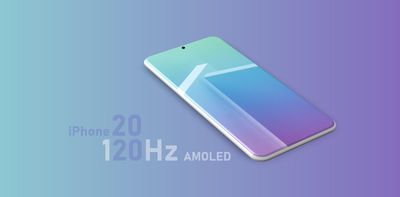Back in July, we reported on a rumor that Apple is considering using a switchable 60Hz/120Hz refresh rate screen on its 2020 iPhones, allowing for a smoother on-screen experience. DigiTimes now reports that industry observers believe many 5G-era smartphones are likely to use upgraded displays capable of up to 120Hz refresh rates, reigniting speculation that next year's iPhones could use Apple's ProMotion display tech.

However, DigiTimes notes that whether Apple will adopt displays with a 120Hz refresh rate "remains to be seen."
The arrival of 5G is ushering in hardware upgrades to support related applications and services. It is expected more 5G smartphones will come with displays offering high refresh rates that can enhance user experience. It remains to be seen whether Apple will launch its first 5G iPhone in 2020, or will adopt displays with 120Hz refresh rate...
The DigiTimes article bases its prediction on the penetration rate of over 120Hz panels in the gaming notebook segment. Observers note that this has surpassed 30 percent and is still growing, which is prompting panel makers to step into the sector and develop panels with refresh rates ranging from 120Hz to 240Hz.
The gaming-oriented Razer Phone 2 has such a panel with a fast refresh rate, while Asustek's ROG Phone II, which launched in the second half of 2019, also boasts one. DigiTimes also notes that the Google's Pixel 4 comes with a 90Hz display and Sharp's recently released Aquos R3 features a 6.2-inch IGZO 120Hz display, while several Chinese brands are expected to roll out models with higher refresh rates in 2020.
Apple is considering a switchable 60Hz/120Hz refresh rate screen on the iPhone in 2020, and is discussing with Samsung and LG. pic.twitter.com/4aoU303umu — Ice universe (@UniverseIce) July 21, 2019
Having a similar display on a new iPhone without sacrificing battery life would obviously be a big draw. Apple already uses variable refresh rate technology in its iPad Pro models, and markets the tech under the moniker "ProMotion," which it says dynamically adjusts the display to the movement of content for fluid scrolling, greater responsiveness, and smoother motion. It does all this on the fly, which means it also conserves battery life.
Of course, Apple's iPad Pro models use LCD panels rather than OLED, and rumors have suggested Apple will complete its transition to an all-OLED iPhone lineup in 2020 with new 5.4-inch, 6.1-inch, and 6.7-inch devices.
If Apple is indeed in discussion with Samsung and LG to bring a ProMotion-style screen to a new breed of OLED iPhones, as one leaker claimed earlier this year, then it would raise next year's smartphone performance bar even higher.























